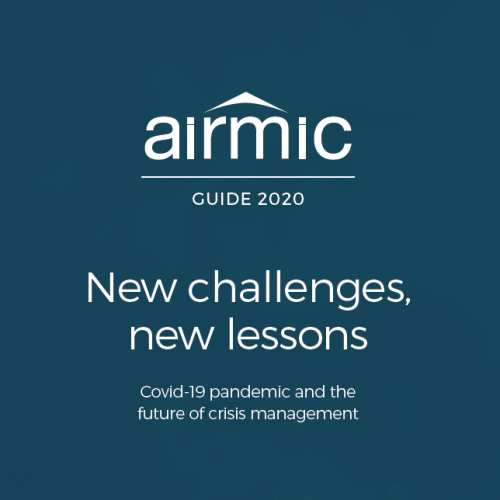The Covid-19 pandemic - Crisis management
Foreword
DOWNLOAD THE FULL GUIDE PDF HERE
Covid-19 presents significant challenges to people and organisations around the world, and as the disruption continues to evolve, it’s important that organisations remain alert and agile and prepared to respond as the context changes.
The purpose of this report is to explore the challenges organisations have faced during the Covid-19 crisis, highlight lessons learned and still being learned, and make suggestions for changes to crisis management practice to build resilience – whatever the future might hold. The report is aimed at Airmic members who have a responsibility for organisational resilience, as well as their top management, their peers within their organisation and external stakeholders.
The report uses information from a meeting of the Airmic risk management special interest group in May 2020, a ‘pulse survey’ survey of Airmic members conducted in August 2020 with a focus on pandemic crisis management, as well as other sources of contemporary information, including Airmic partner Control Risks.
This report assumes that a pandemic is not a ‘black swan’ risk. The black swan metaphor has promoted a mentality and sense of helplessness in the face of daunting threats and provided a cover for failing to act in the face of clear and present dangers.
The black swan has one benefit, which is that it encourages people to expand their ideas of what might happen. If they take the concept to heart, they can build resilient systems with safeguards. But mostly the metaphor has been a justification for inertia and inaction in face of expert warnings. It reinforces a dysfunctional status quo in which many people believe that neither we nor our governments have any power to stand up to looming dangers.
Epidemiologists and other public health experts have been warning that the world was ripe for the next pandemic, and that global air travel, climate change and antibiotic resistance make us more vulnerable.
Michele Wucker: Washington Post, March 2020
Michele Wucker is a Chicago-based strategist and author of The Gray Rhino: How to Recognize and Act on the Obvious Dangers We Ignore.
In 2020, the World Economic Forum identified infectious disease on the dimension of potential impact in its Long-Term Risk Outlook Top 10 – disease has been on the equivalent list for over ten years.1
When Airmic members were asked in March 2019 to draft their ‘Nightmare Headline’, a pandemic featured.2
In September 2019, CNN reported: “The risk of a global pandemic is growing – and the world isn’t ready, experts say.” 3
1 Global Risks Report – World Economic Forum 2020, reports.weforum.org/the-global-risks-report-2020
2 Guide to Emerging Risks – Airmic 2019
3 Global Pandemic is Growing – CNN 2019, https://edition.cnn.com/2019/09/18/health/who-pandemic-report-intl-hnk-scli/index.html
- Fill out an application Our membership manager will assess your eligibility against our criteria.
- Complete your profileIf you are eligible for membership you will be asked to answer a few questions about yourself.
- PaymentYou can make payment online using a card or request an invoice.

